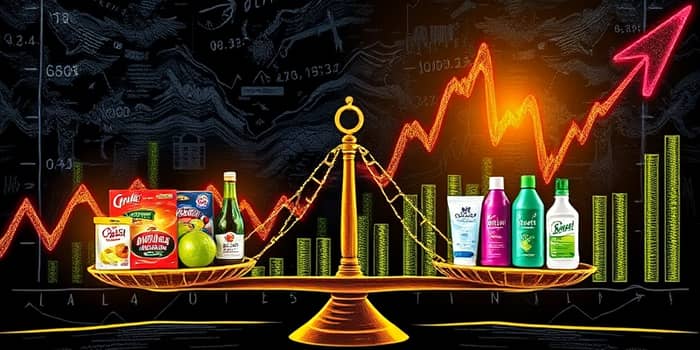
In an era defined by economic uncertainty and market turbulence, consumer staples emerge as a reliable anchor for investors. These essential goods companies provide a steady cushion, offering both income stability and defensive shelter when growth falters.
Consumer staples encompass firms that sell products people purchase regardless of economic swings. These are not luxury items but everyday necessities that maintain consistent demand through booms and busts.
Because these everyday goods meet essential needs, their sales remain resilient even when consumers tighten budgets. This protective quality underpins their reputation as a defensive play.
Through March 2025, the Vanguard Consumer Staples ETF (VDC) delivered gains exceeding 5%, defying declines across more cyclical sectors. By comparison, the Consumer Discretionary Select Sector SPDR ETF (XLY) tumbled almost 7% over the same period.
Historical data show that staples return an average of 8.2% annually over the past decade through April 2021, trailing the S&P 500’s 11.86% overall but outperforming during downturns. The recent P/E compression to 19.8x from a three-year norm of 28.3x signals potential undervaluation relative to history.
Consumer staples excel when investors seek refuge from volatility. With forecasts placing recession odds at up to 60% this year, capital has shifted toward sectors seen as recession-resilient.
Even as tariffs on goods from Mexico, Canada, and China raised input costs, staples companies demonstrated strong pricing power under pressure, passing costs to consumers while preserving margins.
Several factors combine to lift staples ahead of broader markets during rough patches:
Volume and unit growth are gaining emphasis over pure price hikes. As promotional efforts intensify, companies aim to sustain volumes, offsetting slower unit pricing momentum.
Cost management capabilities have improved through supply-chain efficiencies and targeted procurement strategies. These tactics help navigate tariff impacts and logistics challenges.
During market drawdowns, staples act as a natural hedge. Their stocks often trade at a valuation discount in bull markets, only to re-rate when downturns spark a flight to safety.
No investment is bulletproof. Staples face headwinds that could dampen future returns:
Currency fluctuations and a strong U.S. dollar also threaten profits for global operations. Some analysts warn that if recession fears ease, staples may lag in a renewed risk-on environment, capping upside potential in extended bull runs.
Given their resilience and income features, consumer staples sit at the heart of defensive allocation strategies. Investors looking to hedge portfolio volatility can lean into these names alongside utilities and other non-cyclical sectors.
Dynamic asset allocation—shifting weight toward staples as indicators flash caution—leverages their stability in uncertain times without abandoning growth opportunities entirely.
Key companies to monitor include Coca-Cola, Procter & Gamble, Walmart, PepsiCo and Unilever, while VDC provides a broad, cost-efficient ETF option for sector exposure.
As 2025 unfolds, looming economic and geopolitical uncertainties suggest that defensive plays will remain in focus. Consumer staples, underpinned by consistent consumer demand patterns and reliable dividends, stand poised to deliver both stability and modest growth.
Investors should weigh the sector’s current valuation discount, strong pricing power, and proven recession resilience against margin headwinds and potential currency risks. For those seeking to bolster portfolios against volatility, staples offer a time-tested path to preservation and income generation when markets turn turbulent.
References













